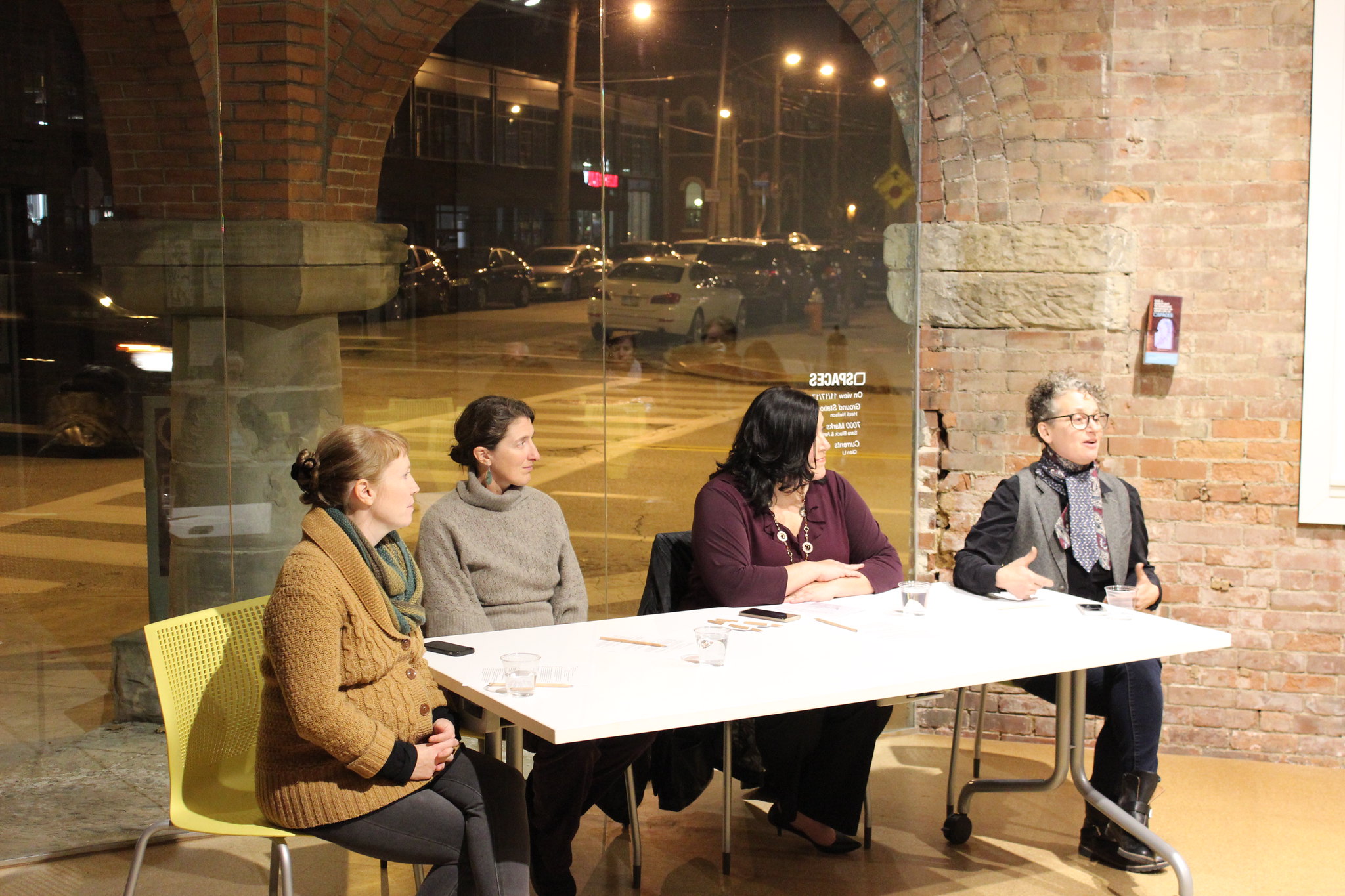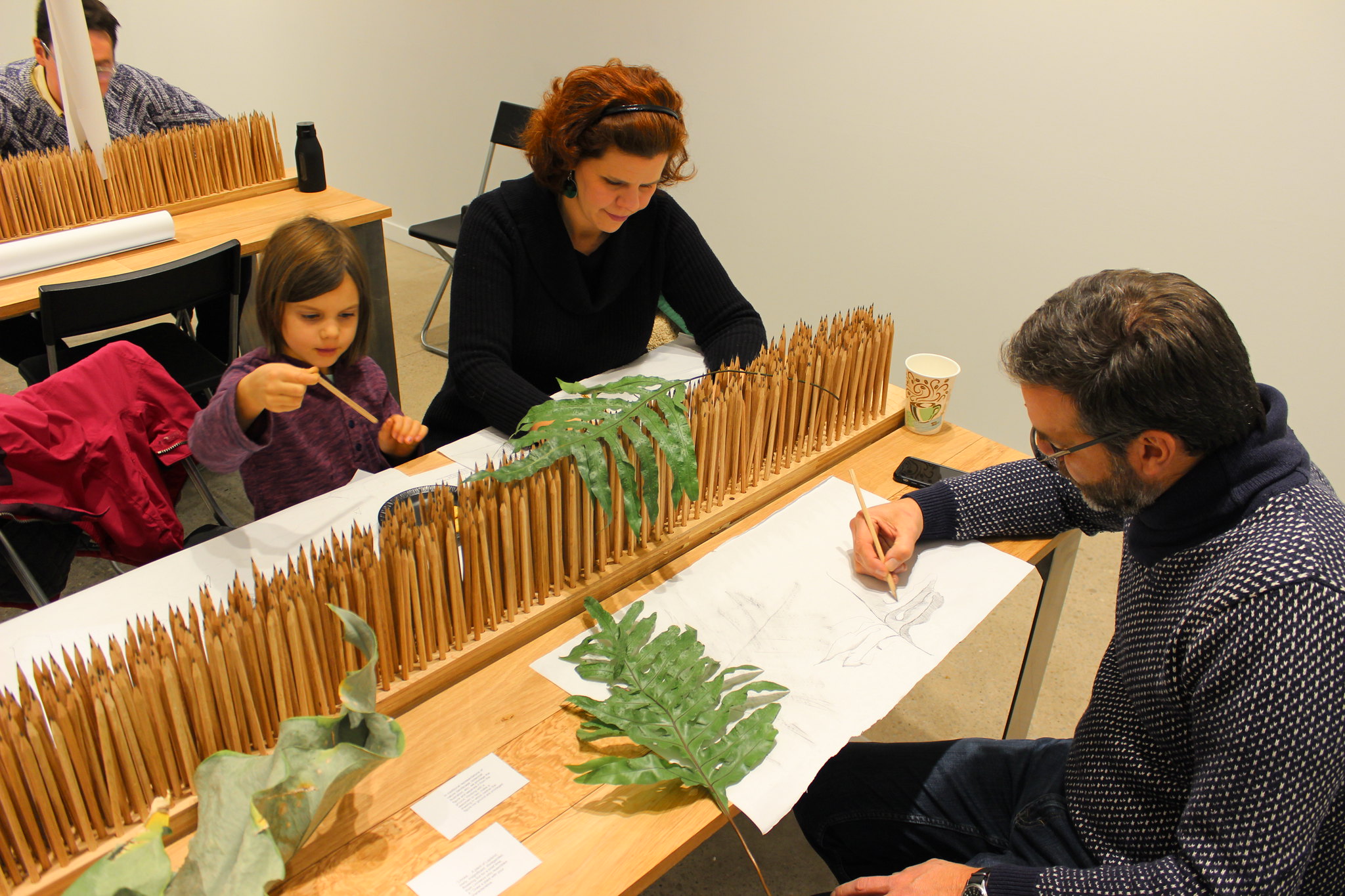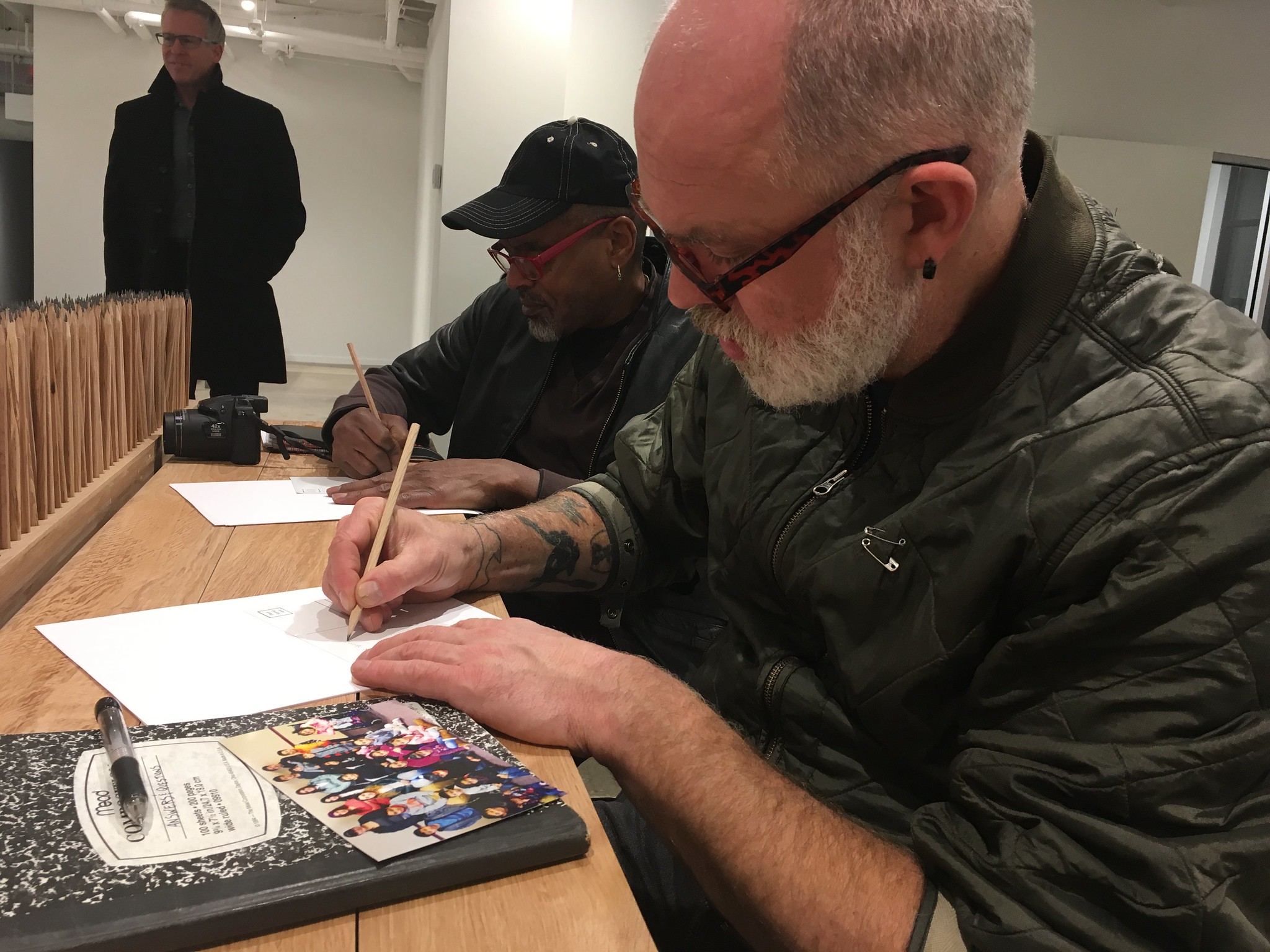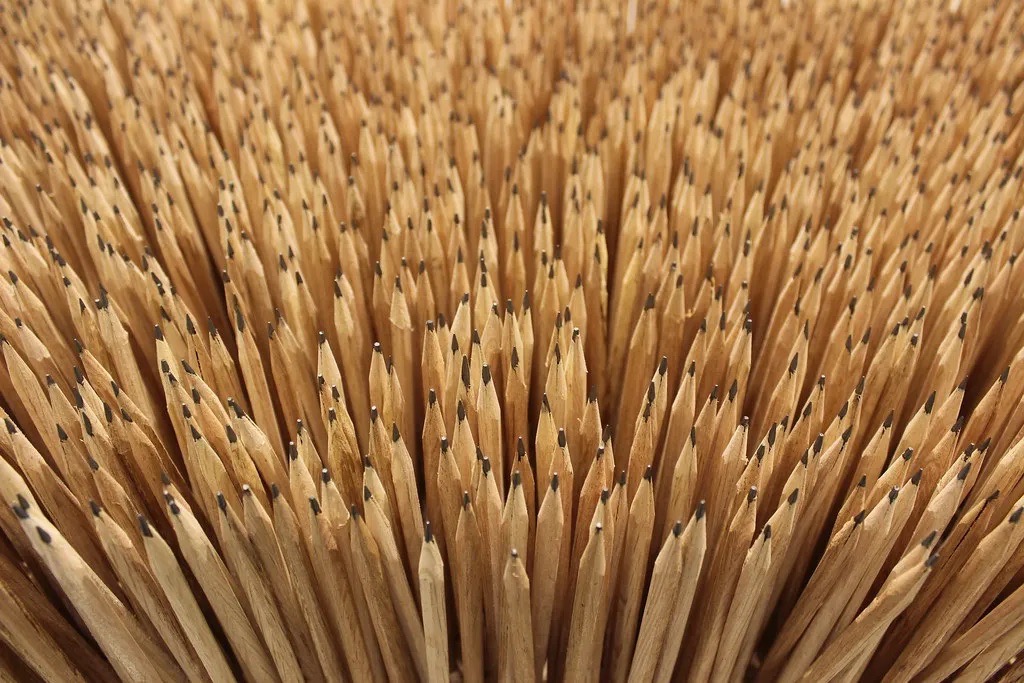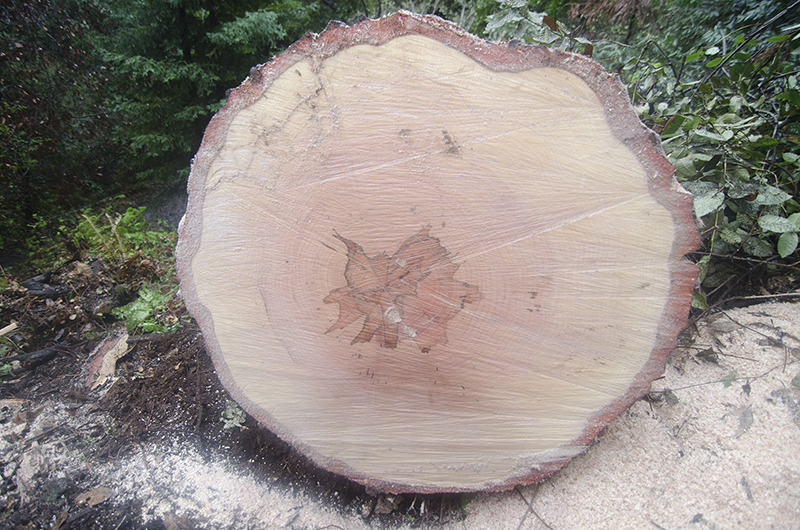
7000 Marks, 2016-ongoing
SOD7 – Sudden Oak Death Symposium
The Presidio
San Francisco, California
In March 2016, on the first rainy day in California in two years, we felled a tanoak tree infected with Sudden Oak Death (SOD) on the Big Creek Reserve. The pathogen Phytophthora ramorum has traveled on the global nursery trade to the US. Trees infected with SOD are quarantined inside the boundary of their county line until processed into lumber and kiln dried. This tightening of boundaries is a move toward environmental conservation, but echoes a rising tide of nationalism, xenophobia and boundary reinforcement on a global scale. Working with scientist and sawyers, we milled and kiln dried the tree so the the wood to lumber, could be shipped to Chicago where we made it into 7,000 pencils. And this is the real beginning of the project, which will continue until the pencils are fully used, perhaps beyond Sara and my lifetimes.
7000 Marks reflects on Joseph Beuys’ 7000 Oaks, the planting of oak trees in Kassel Germany in 1982, but this time with new questions. The project brings people together to ask, what does it mean to be native to a place, whether human, plant, animal or fungus? The boundaries that we draw on multiple scales (on a cellular level, an object level, to societal and global levels) are in some ways fictions, but our beliefs and rhetoric around them do have real political, social and ecological consequences. How can questions around boundaries reframe our thinking about human migration, globalization, its effects on ecosystem stability and our fear or embrace of the Other?
Writing about this project can be found in:
– Issue 44 of Antennae, “Truth.Climate.Now,” Summer 2018
– The Center for Sustainable Practices in the Arts, Quarterly #22, The Unknown & Uncertain, 2019
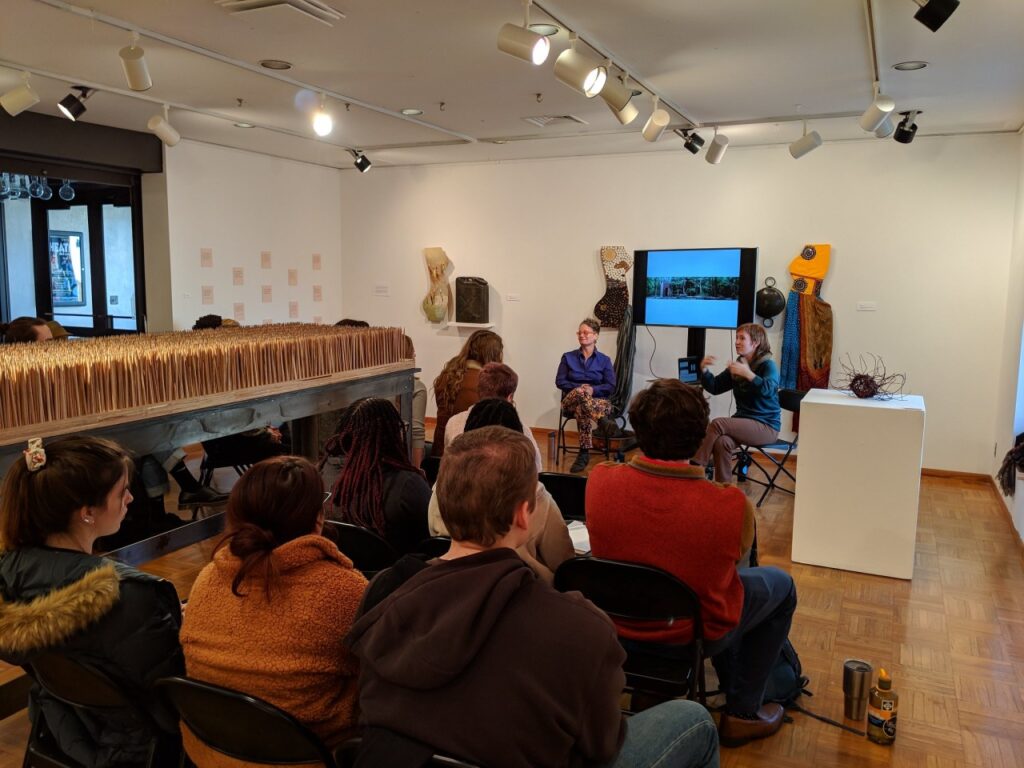
Hartmann Gallery Workshop, 2019
Bradley University, Peoria, IL
7000 Marks was a sculptural contribution to the exhibition titled Change Agents: Midwest Women Eco Artists, that was co-organized with the symposium Midwest Women Artists: Champions of the Environment, held at Bradley University in Peoria, IL. For this symposium I was a panel participant, with Frances Whitehead, on Art Embracing Science organized and moderated by Susan Snodgrass. In addition to this public presentation, Amber Ginsburg and I led a workshop to yet again activate the tanoak pencils. We gave a talk and led a workshop with members of the public as well as several art, science and art history classes at Bradley. Like the SOD7 workshop we led a hybrid drawing and creative writing exercise.
Workshop prompts:
Imagine yourself as hybrid with an other than human system or being sharing skills and qualities (this can be something really small like a virus, or really big with like the wind, or an animal or plant being).
Describe your experience as this hybrid being in the form of a letter, a journal entry, a journalistic account, any form of first person reflection.
As this entangled entity, you have experienced a minute, a decade for maybe a lifetime. In writing, reflect upon a significant event that you have experienced within the setting/world you have created.
Draw the thing that you are. In this drawing, put emphasis on relationships over bounded edges.
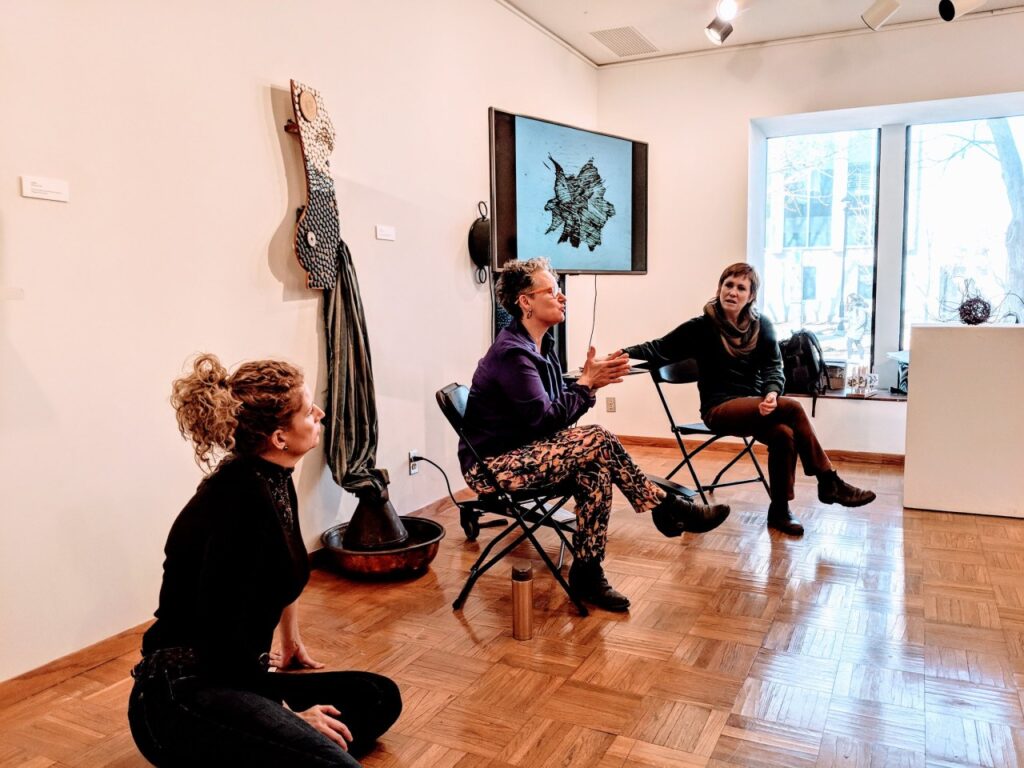
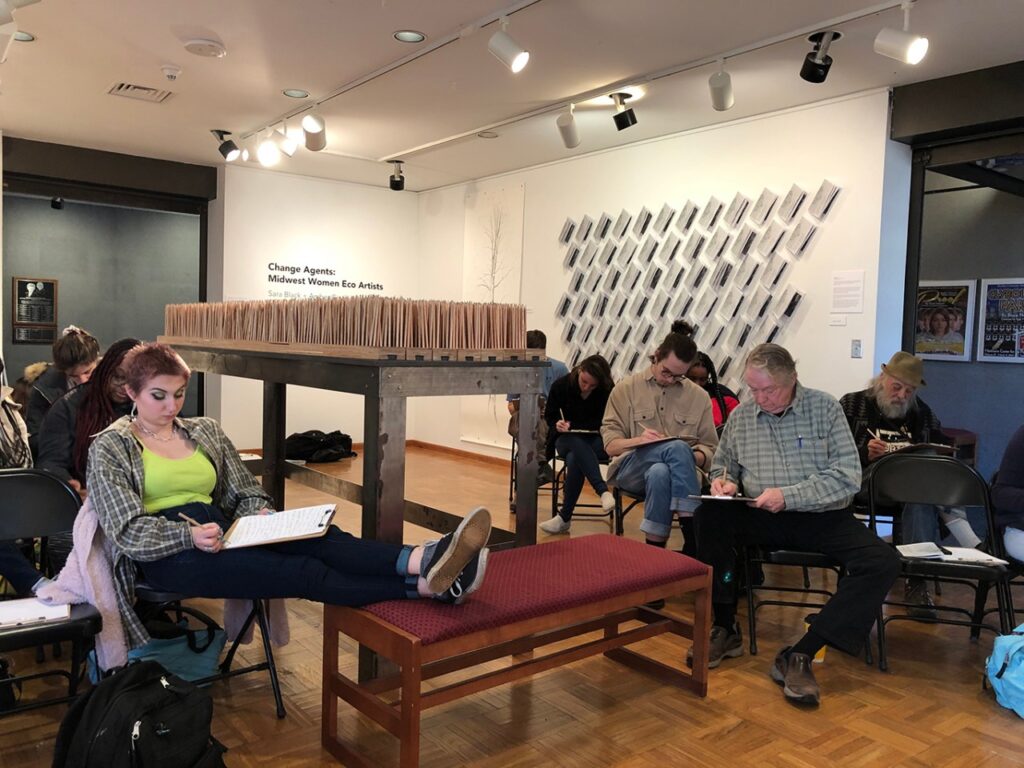
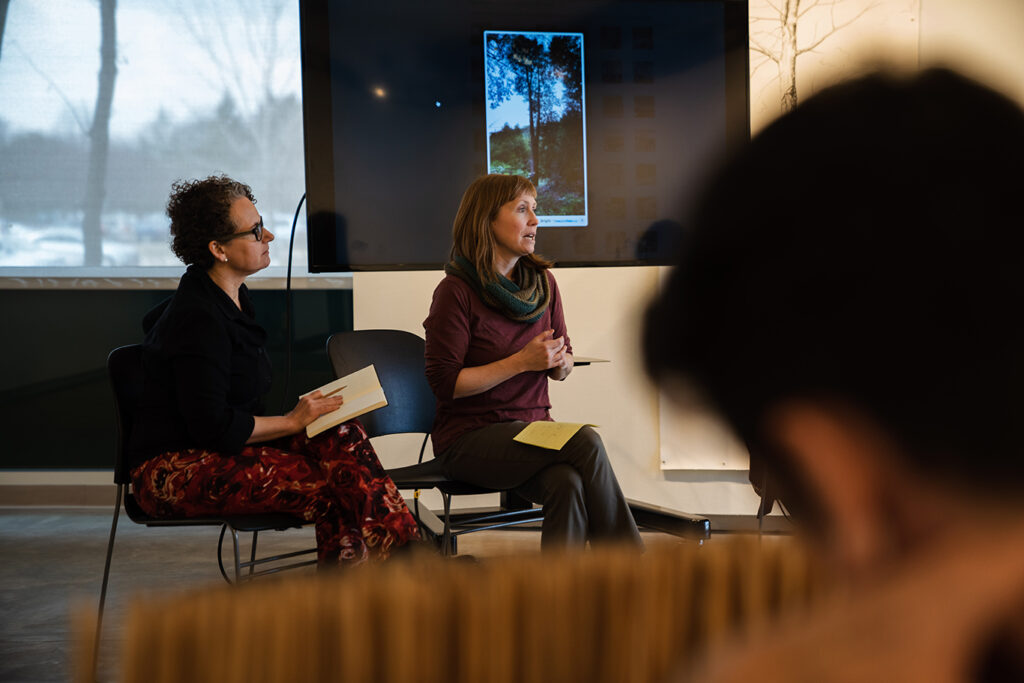
Seerveld Gallery Workshop, 2019
Trinity College, Palos Heights IL
During the exhibition of 7000 Marks at Seerveld Gallery, my collaborator Amber Ginsburg and I activated the 7000 pencils through three workshops in collaboration with visual artist Jessie Mott, science fiction author Sue Burke, and Immigration Lawyer Maria Woltjen. At the outset of each workshop Amber and I lead a short introduction to 7000 Marks after which we move into a workshop where participants use the pencils.
WRITING – What do Plants Want?
Sue gave a short lecture about her work and led the audience through a creative writing workshop, using provocations like, “What do plants want? Plants are aware and active, each one with its own capabilities. A plant sees, smells, feels, hears, knows where it is, remembers. Plants lead complex and active lives.” Her writing prompt: One person writes a sentence (a tweet) based on one of the following prompts, then pass the paper to the next person, who answers as the plant, then passes it along for a few turns to create a dialogue. A homeowner wants to pick out a tree at a nursery for their lawn. A lumberjack must cut down a tree. A bird wants to build a nest in a tree. A farmer is caring for an orchard. A child wants to climb a tree, etc.
DRAWING – Hybrid Drawings
Jessie also presented on her watercolor paintings of hybrid animal creatures through a short lecture and then led the audience through a speculative drawing exercise. Draw a dream you had recently. What would you look like if you became an animal? What would it look like if you were part animal? Imagine you could grow bigger or smaller and transform yourself into other things. Jessie place props around the room, from taxidermied animals to scientific models.
LETTER WRITING – The Rights of Child RefugeesMaria led an informative talk about detention centers in Chicago and around the United States and spent quite a lot of time describing the legal rights of immigrants and refugees into the US. After answering myriad questions posed by the audience, she moved us through a letter writing campaign for those who cared to participate.
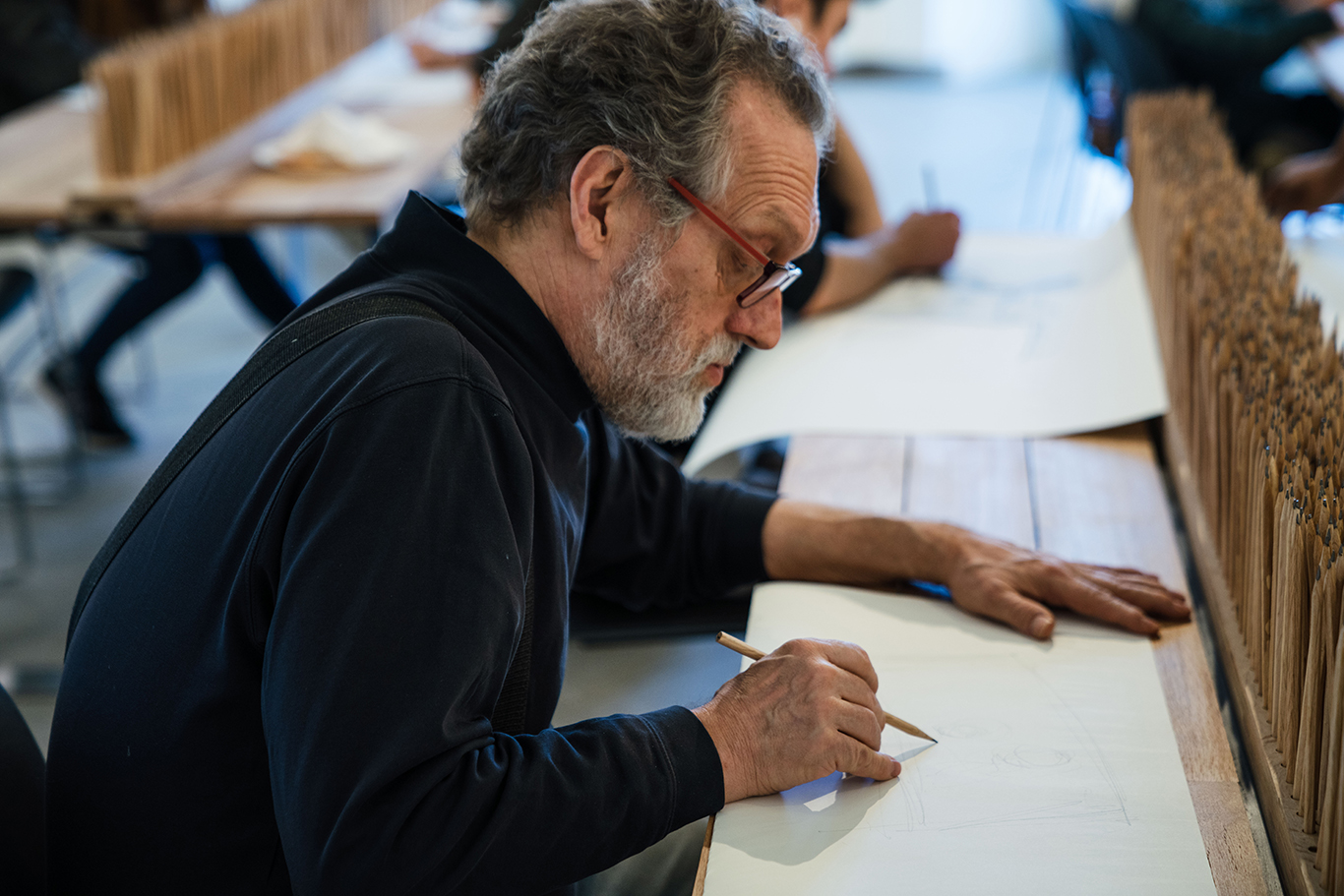
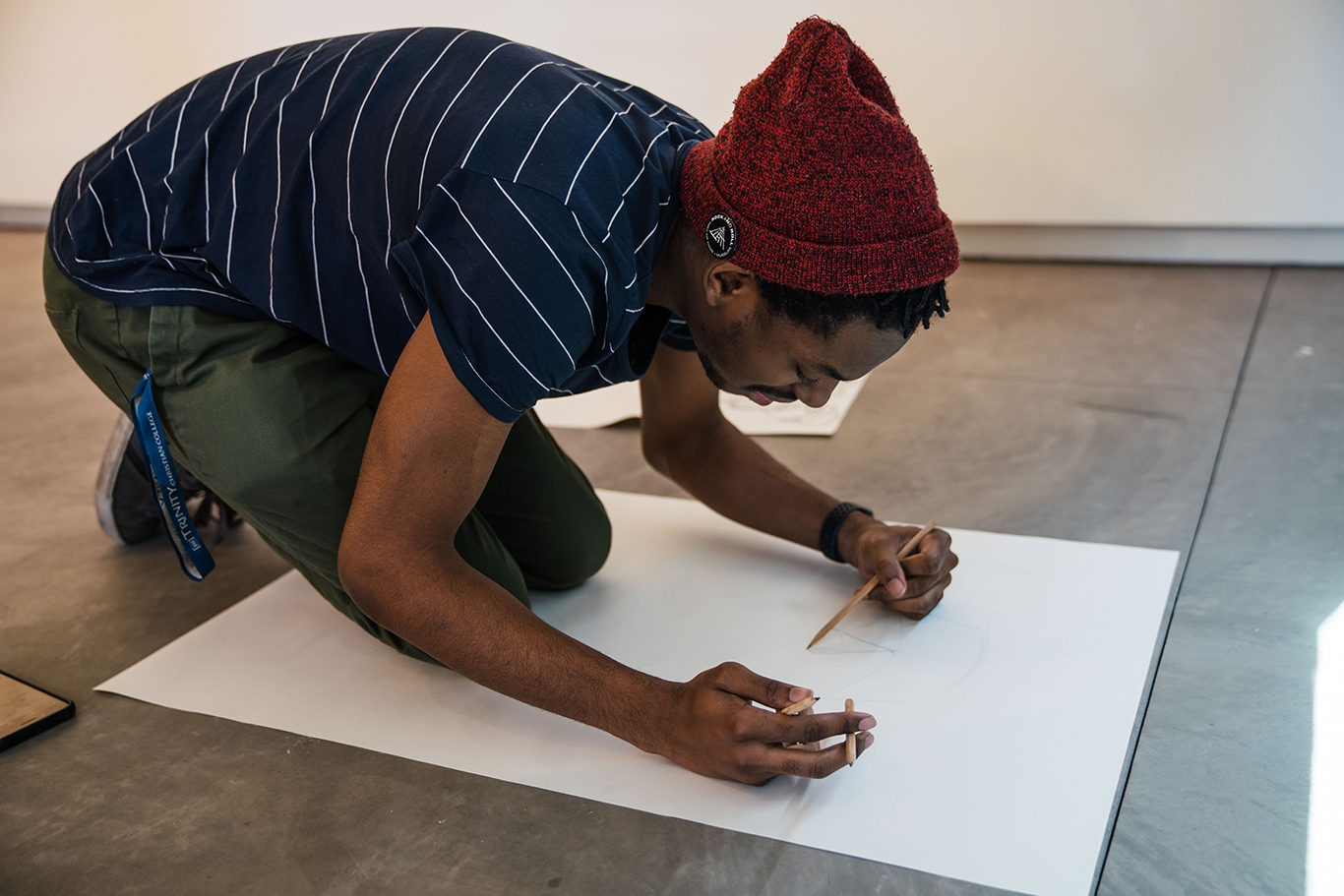
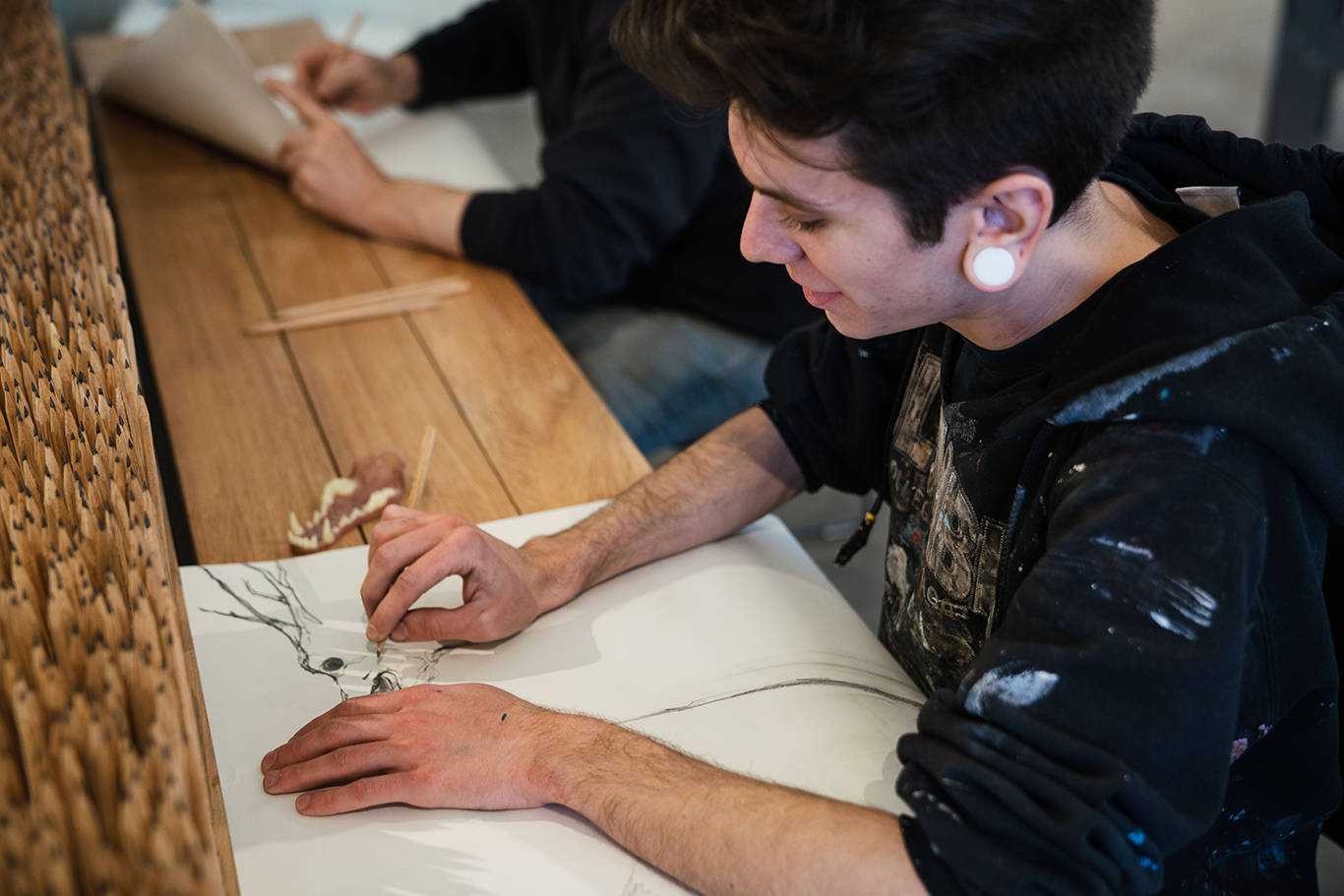
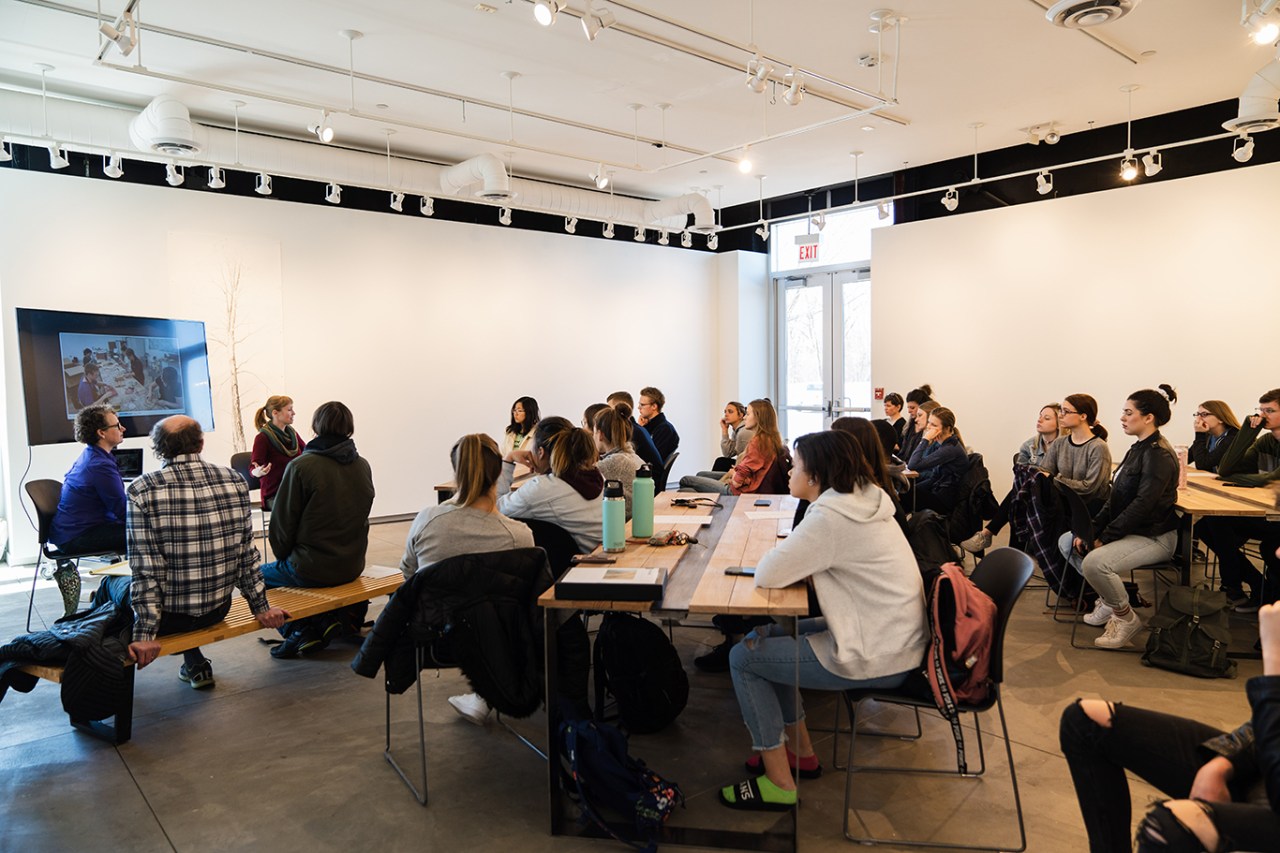
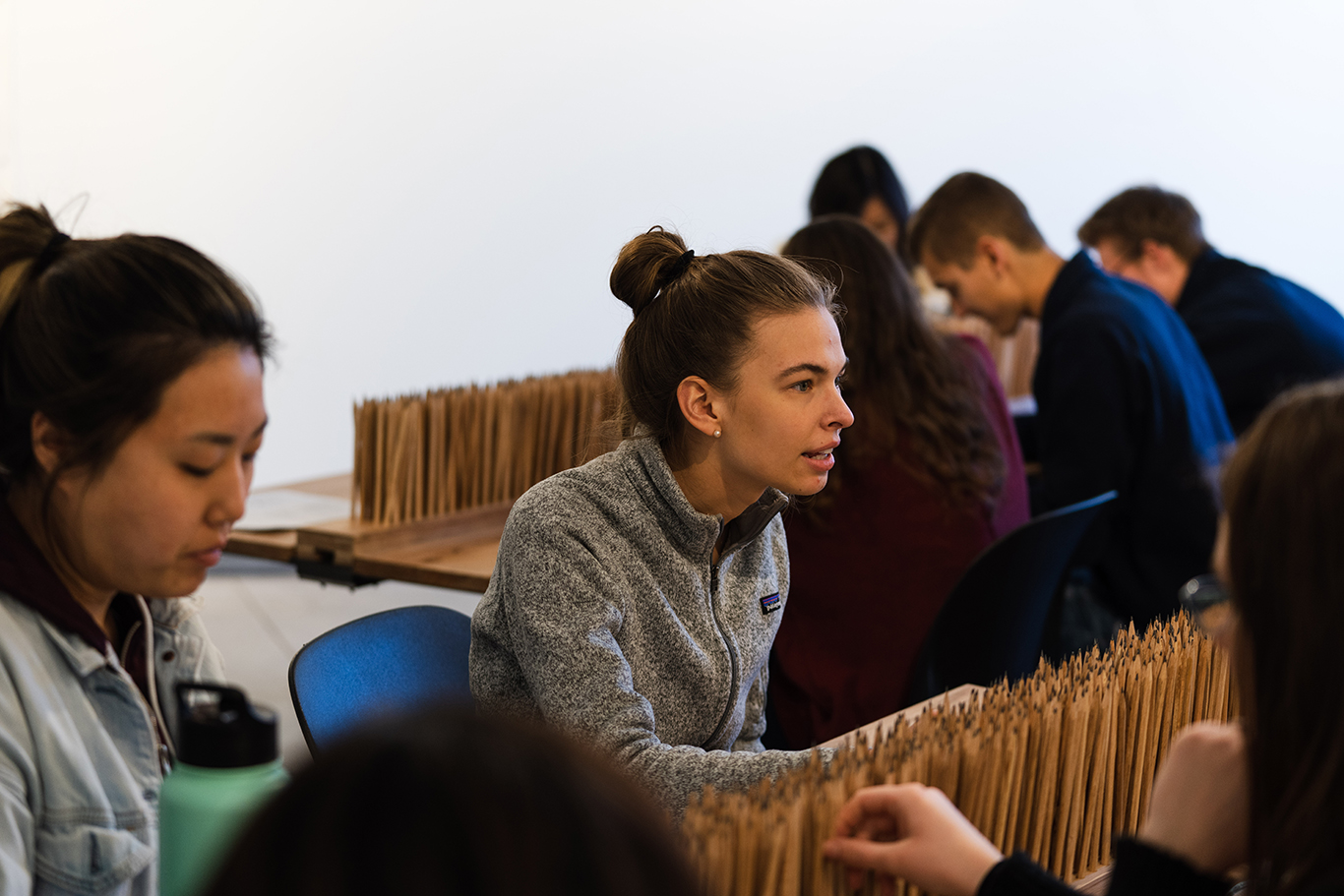

Biographies:
Sue Burke is a writer and translator who has lived in Milwaukee, Austin, Madrid, and now in Chicago. She publishes short stories, poems, and articles in a variety of magazines and anthologies, and her novel Semiosis was published by Tor in February 2018, and its sequel, Interference, in 2019.
Jessie Mott is a Chicago-based visual artist. Mott works primarily in drawing and painting and is best known for her watercolors of hybrid animal creatures. Her collaborative animations with the artist and writer Steve Reinke have been screened widely at national and international venues, including the International Film Festival Rotterdam, VIDEOEX International Experimental Film & Video Festival in Zürich, and the International Short Film Festival in Oberhausen, Germany. Her drawings were featured in Reinke’s video program in the 2014 Whitney Biennial. Mott received an MFA in the department of Art Theory & Practice from Northwestern University and a BS in Studio Art from New York University. She received her MSW from Loyola University’s School of Social Work in 2019 and was 2016-2017 Field Fellow at the University of Chicago.
Maria Woltjen is the Executive Director and founder of the Young Center for Immigrant Children’s Rights. The Young Center’s primary work is to advocate for the best interests, safety and well-being of unaccompanied and separated immigrant children. As part of this work, the Young Center serves as Child Advocate (best interests guardian ad litem) for trafficking victims and unaccompanied immigrant children pursuant to the Wilberforce Trafficking Victim Protection Reauthorization Act of 2008. Ms. Woltjen’s focus is on reforming the immigration system to incorporate a best interests standard and developing a dedicated immigration justice system for children. Throughout her career, Ms. Woltjen has focused on children’s rights, at the Chicago Lawyers’ Committee for Civil Rights, the ChildLaw Center at Loyola University of Chicago School of Law, and now at the University of Chicago Law School. Ms. Woltjen is the recipient of the 1996 Public Interest Law Initiative Distinguished Alumni Award, the 2013 American Constitution Society Ruth Goldman Award and the 2017 UNICEF Chicago Humanitarian Award.
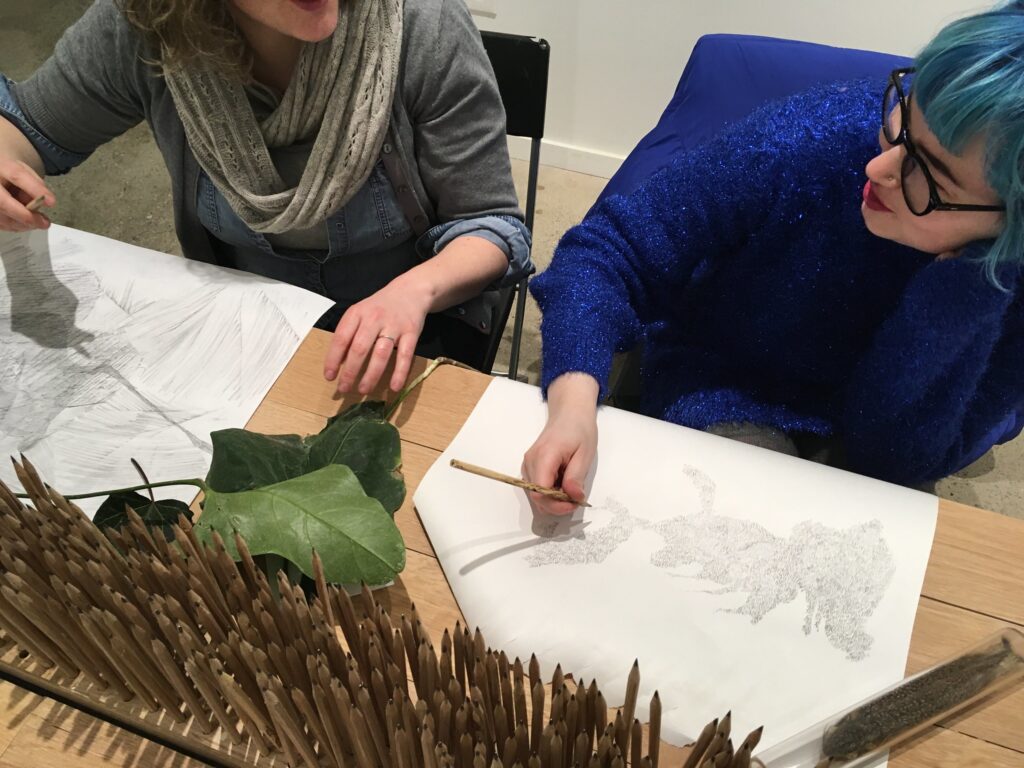
SPACES Gallery, 2017-18
Cleveland, Ohio
During this inaugural exhibition of 7000 Marks, we activated the pencils through three workshops in collaboration with two other visual artists Ryan Dewey and Taryn McMahon, a science fiction author Charles Orberndorf, an immigration activist Veronica Dahlberg and biologist and Sudden Oak Death expert Kerri Frangioso.
CREATIVE WRITING – Looking to geologic pasts to imagine future worlds
Human beings understand the world through human scales of reference, both physically and in time. The study and consideration of geology encourages us to imagine deep time as it reaches into the past and the art of science fiction enables us to consider deep futures. Join artist and geologic thinker Ryan Dewey, science fiction author Charles Oberndorf and 7000 Marks artists Sara Black and Amber Ginsburg in a discussion on these themes and activate the 7000 pencils through a creative writing workshop in which we will aim to imagine outside of the human timeframe into deep futures.
DIRECT ACTION and LETTER WRITING – When concepts of Nativism migrate into the rhetoric of human migration.
The geopolitical tightening of boundaries we are witnessing today run parallel to the ecological community’s commitment to protecting native ecosystems from invasive plant pathogens introduced through global trade, reckless agricultural and extractionist practices. One can argue that the tightening of ecological boundaries to protect native plant and animal communities is a critical step toward conservation, but how may we problematize the way these drawn and reinforced boundaries echo the anti-immigration sentiments on display by our current administration and beyond? Join UC Davis biologist Kerri Frangioso, immigration activist Veronica Dahlberg, and 7000 Marks artists Sara Black and Amber Ginsburg in a discussion on these themes and activate the 7000 pencils through letter writing and direct action.
SPECULATIVE DRAWING – How scientific classification systems reveal human desireThinking through biological classification systems as another means of projecting human desires or epistemological frameworks onto the world of nonhuman beings, we will come together to speculate outside of our human frame and attempt to imagine how we can adapt our relationships to nonhuman beings in an era of ecological uncertainty. Join Cleveland based artist Taryn McMahon and Chicago based R & D artists Sara Black and Amber Ginsburg in a discussion and speculative drawing workshop using the 7000 handcrafted pencils currently on view at SPACES.
